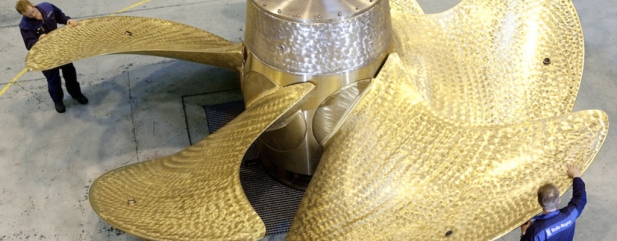Archived article
Please note that tax, investment, pension and ISA rules can change and the information and any views contained in this article may now be inaccurate.
You could make a lot of money from Rolls-Royce shares

A lot of fund managers look for discounted shares in high quality companies that happen to be facing short-term struggles. Individuals like Fidelity’s Alex Wright, who runs the Fidelity Special Situations Fund (GB00B88V3X40) or Lindsell Train’s Nick Train spring to mind.
We believe that Rolls-Royce (RR.) is an excellent example, and a super investment opportunity, for investors willing to take a longer-term view.
This is not the luxury cars company. Those fancy autos are made by BMW and have been for years. We are talking about the UK-listed designer and manufacturer of engines and huge gas turbines that power planes, trains and ships.
It has enjoyed prolonged spells of growth over the years. In the 10 years or so between 2003 and 2014 Rolls-Royce’s share price increased more than 10-fold to nearly £13.00.
Since then life hasn’t been as easy for the business. It was struck down by a corruption scandal and multiple profit warnings which nearly saw the company fold, according to its current chief executive officer (CEO) Warren East.
But the former boss of ARM Holdings, the UK chip designs champion that was sold to Japan’s Softbank for £24.3bn in 2016, is making real headway in putting the pieces back together again.
TURNING OVER A NEW LEAF
We like the current focus on efficiency improvement and sharper execution that East is insisting on. The recent re-testing of its Trent-1000 engines, while irritating perhaps, is evidence of Rolls-Royce’s pursuit of engineering and support excellence.
We also think the CEO is right to exit the commercial marine business (now up for sale) and shrink the number of divisions from five to three. Rolls-Royce last month sold its fuel injection technology business for £610m.
Cash windfalls from such sales can be ploughed back into more exciting growth projects, such as the development effort now going into hybrid-electric aero-engines, alongside partner Siemens. This should result in prototype aircraft taking early test flights by 2020.
The key to medium-term progress at Rolls-Royce is getting its engines on to more planes, and those planes flying more air miles. That will accelerate the servicing and parts cycle from which the company earns its profit and cash flow.
The engineering that Rolls-Royce undertakes is very technical and cutting edge science but the business model is fairly straightforward. It designs and builds aircraft engines for Boeing, Airbus and the Eurofighter Typhoon, one side of an effective duopoly in aviation with General Electric of the US.
One in two passenger planes are powered by Rolls-Royce engines, and it has recently been taking incremental market share from its US rival. A little more than half of revenues come from civil aviation contracts.
It also currently provides propulsion systems for the Royal Navy’s nuclear submarines and commercial shipping, although that’s not part of the long-term future. Instead, trains are likely to be a key focus down the line.
SURPRISINGLY SIMPLE MODEL
Rolls-Royce makes very slim profits on average on the actual sale of engines. Some are even sold below cost as a loss-leader. The profits come from parts and servicing contracts over typical 25-year engine lifecycles. As you might expect, this ramps up with age.
A new engine doesn’t require much fixing in the early years, but once they hit about five years old wear and tear begins to take its toll, giving Rolls-Royce about 20 years of premium profit-earning potential. And that’s when the real cash flow starts rolling in; liquid financing that goes back into research and development and shareholder dividends.
Importantly, financial results are showing real signs of improvement under East’s streamlined strategy. Full year 2017 results showed every division performing better than analysts had forecast, with underlying pre-tax profit topping £1bn and 25% ahead of 2016’s equivalent figures.
It’s no wonder the shares were the biggest FTSE 100 riser on the day (7 March), jumping 11.5%.
That makes 2017 the first year of profit growth since 2013. There was also a significantly improved cash performance, churning out nearly £1.3bn of free cash flow versus the £490m cash burn in 2016.
There is clearly more work for East and his team to do, both operationally and in rebuilding confidence in the market, but there are now more positive signs than over the past few years.
Revenue and profit performance have been rebased for 2018, with operating profit of £435m expected. This makes the stock look pricey in price to earnings (PE) terms but lower expectations also provide the platform for rapid recovery beyond. Close on £1bn of operating profit by 2020 is anticipated, by which time a £10.00 share price would imply a more realistic PE of 23.
We remain big fans of the company and believe there is scope for substantial shareholder returns over the next few years.
Important information:
These articles are provided by Shares magazine which is published by AJ Bell Media, a part of AJ Bell. Shares is not written by AJ Bell.
Shares is provided for your general information and use and is not a personal recommendation to invest. It is not intended to be relied upon by you in making or not making any investment decisions. The investments referred to in these articles will not be suitable for all investors. If in doubt please seek appropriate independent financial advice.
Investors acting on the information in these articles do so at their own risk and AJ Bell Media and its staff do not accept liability for losses suffered by investors as a result of their investment decisions.
 magazine
magazine











